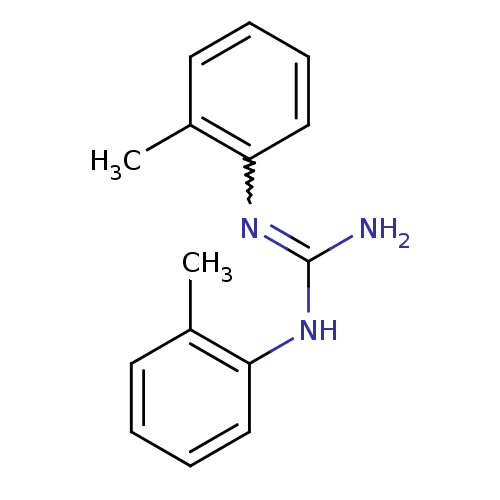BDBM81982 CAS_97-39-2::DITOLYLGUANIDINE::DTG::Di-o-tolylguanidine::Tol2Gdn::cid_7333
SMILES Cc1ccccc1NC(N)=Nc1ccccc1C
InChI Key InChIKey=OPNUROKCUBTKLF-UHFFFAOYSA-N
Activity Spreadsheet -- Enzyme Inhibition Constant Data from BindingDB
 Found 4 hits for monomerid = 81982
Found 4 hits for monomerid = 81982
TargetSigma non-opioid intracellular receptor 1(Homo sapiens (Human))
National Institute On Drug Abuse
Curated by ChEMBL
National Institute On Drug Abuse
Curated by ChEMBL
Affinity DataIC50: 15nMAssay Description:Inhibition of specific binding of [3H]NANM of sigma binding site in Guinea pig brain membranesMore data for this Ligand-Target Pair
TargetSigma non-opioid intracellular receptor 1(Homo sapiens (Human))
National Institute On Drug Abuse
Curated by ChEMBL
National Institute On Drug Abuse
Curated by ChEMBL
Affinity DataIC50: 53nMAssay Description:Inhibition of specific binding of [3H]DTG to sigma binding site in Guinea pig brain membranesMore data for this Ligand-Target Pair
TargetSigma non-opioid intracellular receptor 1(Homo sapiens (Human))
National Institute On Drug Abuse
Curated by ChEMBL
National Institute On Drug Abuse
Curated by ChEMBL
Affinity DataIC50: 18nMAssay Description:Inhibition of specific binding of [3H]DTG to sigma binding site in Guinea pig brain membranesMore data for this Ligand-Target Pair
TargetSigma non-opioid intracellular receptor 1(Homo sapiens (Human))
National Institute On Drug Abuse
Curated by ChEMBL
National Institute On Drug Abuse
Curated by ChEMBL
Affinity DataIC50: 28nMAssay Description:Inhibition of specific binding of [3H]DTG to sigma binding site in Guinea pig brain membranesMore data for this Ligand-Target Pair
